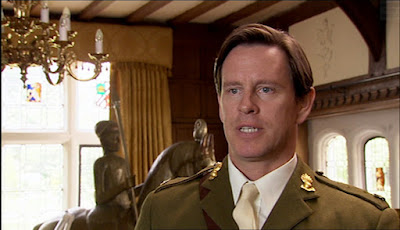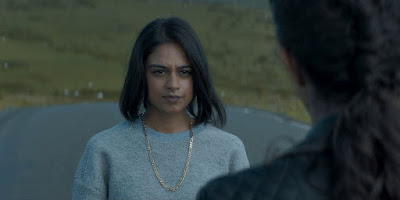Synopsis:
The TARDIS materialises on the beach of a strange island, dominated by a huge pyramid structure. The scanner shows a calm grey ocean, with no sign of life - though Ian thinks he glimpsed movement just as the Doctor switched the screen off.
They go outside to explore, picking their way through jagged rock formations and over glass-like sand. The Doctor advises that Susan not go into the sea, as they don't know what creatures might lurk beneath the surface. Instead she decides to have a paddle in a rock pool. One of her shoes falls in and Ian stops her from stepping in as he sees it start to dissolve. This is not water but acid. As the pool is a tidal one, it means that the entire ocean is acidic, which explains the glass on the beach. Ian lends Susan his boots so that she can return to the TARDIS to fetch a spare pair of shoes.
A sinister looking figure clad head to foot in black rubber has been observing them.
Barbara discovers a torpedo-like glass craft on the beach, obviously designed to carry a single operator through the acid sea. A black rubber figure is seen within, but it proves to be an empty suit. Both the craft and the suit have holes in them, and they realise that the occupant has been dissolved.
When Susan fails to return, and is not inside the TARDIS, they suspect she has gone to investigate the pyramid.
When they get there, they split up - the Doctor walking round in one direction, and Ian and Barbara the other. The Doctor then also disappears. They discover that there are hidden panels in the walls of the structure, and soon all find themselves inside. Susan is attacked by the black-clad figure, but it suddenly falls dead with a knife in its back. Ian spots a hooded man dressed in white robes. When he tries to speak to him, the man is attacked by another black-clad figure. This one falls through a hidden panel, plunging into the acid sea below.
They are all reunited in a large chamber in which there is a large machine. The old man in white robes introduces himself as Arbitan. This machine is known as the Conscience of Marinus - that being the name of this world. The Conscience was designed to suppress evil and wrong-doing, making Marinus one of the most peaceful planets in the galaxy. However, a man named Yartek and his followers - the Voord, who are the figures who dress in black rubber - found themselves immune to its effects. Arbitan has now perfected it so that it will work on them as well, but he requires the four micro-circuit keys which operate the Conscience to do this. To prevent these falling into hostile hands, they have been scattered across the planet. Arbitan asks the Doctor and his companions to go and fetch them. They refuse and return to the TARDIS - only to find that Arbitan has placed a force-field around it. They will have to comply with his wishes.
He explains that he has sent several of his followers to fetch the keys - including his daughter - but so far none have returned. They are given special wrist-worn travel dials programmed to reach each key location. Barbara goes on ahead, so the others quickly follow.
As soon as they have gone, a Voord enters the Conscience chamber and kills Arbitan.
The Doctor, Ian and Susan find themselves outside a large building, with no sign of Barbara. Ian spots her travel dial lying on the ground, and is horrified to find that it has blood on it...
Next episode: The Velvet Web
Data:
Written by: Terry Nation
Recorded: Friday 20th March 1964 - Lime Grove Studio D
First broadcast: 5:30pm, Saturday 11th April 1964
Ratings: 9.9 million / AI 62
Designer: Raymond P Cusick
Director: John Gorrie
Guest cast: George Coulouris (Arbitan), Peter Stenson, Martin Cort, Gordon Wales (Voord).
Critique:
Following the success of his Dalek story, Terry Nation was approached about contributing a further script. This was to have been a historical one, set against the backdrop of the Indian Mutiny - a story known as "The Red Fort". This fifth slot had originally been earmarked for a story by Malcolm Hulke, generally referred to as "The Hidden Planet". This would have seen a world identical to Earth but on the opposite side of the Sun, where the ruler looked like Barbara, and various things would be reversed or inverted. Problems arose and this story was pushed back to later in the season. (It would eventually be written off after multiple attempts to rewrite it over the next two years).
To replace it, Terry Nation was invited in for a meeting with Verity Lambert, David Whitaker and Mervyn Pinfield, and was asked to come up with another futuristic story. It was needed quickly but they knew that he could write swiftly and need little editing.
A follow-up meeting with Whitaker saw Nation come up with the idea of four linked mini-adventures, making up a quest scenario. The writer had already used elements of this form of storytelling to pad out The Daleks.
In its earliest form, the Voord were immune to the Conscience machine and had been ejected from Marinus. Now through interbreeding they had become more like Marinians, and only Arbitan - last of the great scientists who had built the machine - was immune. He needed to dismantle it and put it back together to make it work, and for this needed its keys. The TARDIS crew would have been sent to the first location by a transmat booth, and would only know the location of the next key at each of their destinations, so could not jump ahead.
Strangely, Arbitan is not the villain of the story. Ordinarily, someone who put a force-barrier up around the TARDIS to coerce the travellers into doing what he wanted would be the enemy for the week, and the episode would be spent trying to free the ship and to defeat him. Instead, he's presented more as a neutral character, who initiates further adventures. There is a noticeable jump, however, between the travellers finding the force-barrier and them agreeing to use the travel dials so there may have been more of a struggle, just off screen.
It was hoped - especially by Nation - that the Voord might prove to be just as popular as the Daleks. The newspapers took lots of photographs with Carole Ann Ford posing with one of them (played by Peter Stenson). Verity Lambert made sure to tell the press that they did not feature in every episode, but that there were other monsters to be seen over the course of the story.
Nation gave only a vague description of the Voord, so Daphne Dare designed them based on beetles and on frogman wet suits. The helmets and webbed gloves were made by father and son contractors Jack and John Lovell, whilst their submersibles were made by Shawcraft (builders of the Daleks), who also made the Conscience machine and the titular keys.
In an interview conducted many years later by Steve Cambden for his book The Doctor's Effects, Jack Lovell claimed that it was professional wrestlers who were cast as the Voord, but this was not the case.
George Coulouris was a very big name draw as a guest star, having featured in the Orson Welles classic Citizen Kane. He had worked with William Russell before, and later claimed to have enjoyed his single week on the programme.
You will notice that Coulouris is not playing Arbitan in the early scenes where he is silently walking around the pyramid corridors, with his hood up. Instead, he is being played by extra John Beerbohm. This was because there had to be a very brief fight sequence with one of the Voord.
Arbitan's name derives from "arbiter" - someone who has influence or has the ultimate authority to make decisions.
Marinus was named for the fact that it has a distinctive ocean. Terry Nation had previously given us the scarred Skaro, and will provide descriptive names for many more planets and species over the years.
Ray Cusick had some serious concerns about this story, as it would not be using the same sets and props throughout. The quest nature of the story meant different locations each week, and therefore different design elements. This issue was apparent from this very first episode when, after completing the Conscience machine, there was no money left for the background. Cusick had to resort to black drapes, when the walls should have been lined with books and documents as in a library. The set had elements which were due to be binned following a light entertainment show added to make it more visually interesting.
He also found the director disinterested in the VFX - reporting that he sat reading his newspaper when they were being filmed. When the Voord falls through a wall panel after attacking Arbitan, Cusick pointed out that it looked as if it was simply falling into a broom cupboard. He suggested showing it falling down into the acid sea, achieved using a model shot. A small rubber Voord was dropped down a cardboard tube into a bowl of water, with suitable sound effects added.
William Hartnell has a very unsettled few minutes at the beginning of the episode, with three noticeable fluffs.
Before leaving the TARDIS to explore: "Yes, I don't think... I don't see why not. There's nothing... no danger about".
When asked if the sea could be frozen he responds: "No, impossible at this temperature. Besides, it's too warm".
After Ian has given his boots to Susan: "And if you'd had your shoes on, my boy, you could have lent her hers".
Ian's remark that his boots will give Susan lovely corns was an ad lib by Russell.
Trivia:
- This is the first episode of a story which has always been known as The Keys of Marinus.
- This is the first time that the TARDIS is actually seen to materialise - a model shot filmed at Ealing in early March. It materialises silently.
- In an early version of the script the Doctor told Barbara that he had colour TV in the TARDIS, and had been visiting the BBC when he had a problem with it, but they refused to help. On screen he simply says that his colour scanner is hors de combat - 'out of the fight'.
- Carole Ann Ford wears a green corduroy top in this story - made by her mother.
- Peter Stenson and Martin Cort will both be back playing other characters before this story ends.
- Stenson later wrote about his experience in the Voord costume for a rubber fetish magazine.
- Despite there not being a cliff-hanger leading into this episode from the previous one, Ian is wearing the same Chinese silk tunic from Assassin At Peking, so clearly this follows directly after. This tunic later sold in auction at Bonhams for £2520.
- After Barbara falls through the revolving wall, Jacqueline Hill can be seen in the background of the very next scene, hurriedly trying to get out of shot.
- We also get to see one of the stagehands behind the revolving wall when it opens.
- Later on, William Russell is doing his finest miming-of-an-invisible-wall routine, when Carole Ann Ford passes right in front of him, between him and the TARDIS.
- The plural of the villains in this episode can be both Voord or Voords - both names are used on screen and in documentation.
- As had become the norm, Radio Times publicised the opening episode of the new story, in this case including a paragraph on William Russell:














































